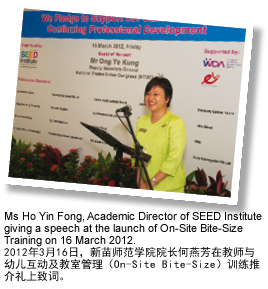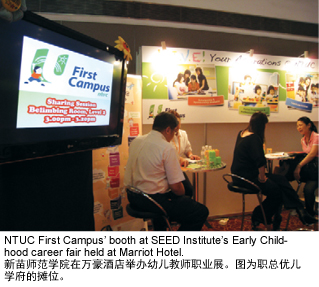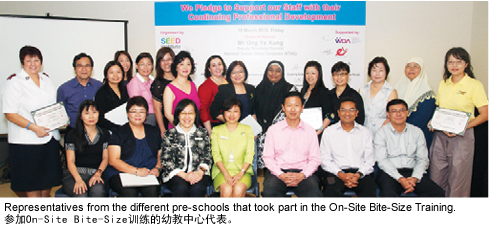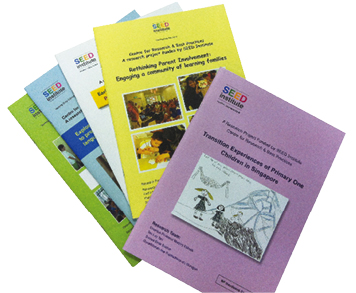|
2012 graduates of SEED Institute.
 Before the establishment of SEED Institute in 1989 training for pre-school teachers in Singapore was difficult to find.
Before the establishment of SEED Institute in 1989 training for pre-school teachers in Singapore was difficult to find.
Ms Ho Yin Fong, Academic Director of SEED Institute, told EduNation that in the 1980s there were only three types of courses: Basic/Fundamental and Intermediate courses for pre-school teachers and Advanced Certificates for principals. The then-Institute of Education was the only teacher training provider and it had a few intakes each year. As such, not many pre-school teachers at that time were trained.
SEED Institute, which was formerly known as the Regional Training and Resource Centre in Early Childhood Care and Education for Asia (RTRC Asia), was therefore specifically created to focus on early childhood education training.
Since its inception, about 10,000 early childhood professionals have gone through its doors. Many SEED graduates have also gone on to hold significant positions in the Early Childhood Care and Education (ECCE) sector.
As a result of its excellent training programmes, SEED Institute was given the status of a Continuing Education and Training (CET) Centre by the Singapore Workforce Development Agency (WDA) for the ECCE sector in 2009. Four years later, SEED Institute became the first CET Centre in the ECCE sector to attain National CET Institute (NCI) status.
The NCI is the pinnacle status conferred by WDA to qualified Singapore Workforce Skills Qualifications (WSQ) CET Centres that demonstrate high quality delivery, and commitment to support workforce development programmes in the WSQ sector which they serve.
With the number of pre-schools that are scheduled to be built, SEED Institute estimates that 1,500 new teachers will be required each year. As the largest single provider of teacher training in the ECCE sector, SEED Institute aims to train 800 new pre-school teachers each year.
The History of the Singapore
Pre-school Industry
 In Singapore, formal pre-school education took root in 1979 when the government started a pre-primary programme to help children from dialect-speaking homes learn English and Mandarin at an early age. But in 1989, it was announced that this programme would end as it cost $80 million a year to run and there were now private sector providers offering similar programmes. In Singapore, formal pre-school education took root in 1979 when the government started a pre-primary programme to help children from dialect-speaking homes learn English and Mandarin at an early age. But in 1989, it was announced that this programme would end as it cost $80 million a year to run and there were now private sector providers offering similar programmes.
Today, however, the government has changed its mind. Fifteen pilot kindergartens will be set up by the Ministry of Education (MOE) in the next few years, with five starting operations early next year.
“Thanks to brain research, thanks to the economists who said that the first five years are important to a child’s development and that the investment potential for later life is high, we are very glad that the government is now paying more attention to the field.
“But I think much more can be done,” said Ms Ho.
Pre-school Challenges
Currently, the pre-school industry is beset by several problems and the chief of these is the dearth of pre-school teachers.
To increase the number of pre-school teachers in Singapore, almost everyone agrees that they have to be better paid. In 2008, their starting pay was somewhere between $1,000 and $1,200 a month. Although this figure has increased pre-school teachers are still not earning as much as their counterparts in other occupations. The lower pay deters many from joining the pre-school industry.
Additionally, despite the work that they do, pre-school teachers are not always given due recognition and respect. Ms Ho notes that the relationship between pre-school teachers and parents in Singapore can be one that is “transactional” when it should be “a collaborative partnership that is filled with trust and respect on both sides”.
The pay and status of pre-school teachers make it challenging to attract the best to join the profession.
There are also uneven standards across pre-schools. Pre-school fees range from a few hundred to more than two thousand dollars a month, and the quality of what they deliver varies. But the amount a parent pays should not necessarily reflect the quality of the school.
In 2001 the MOE set up the Pre-school Qualification Accreditation Committee (PQAC) to oversee the standards and quality of pre-school teacher training for both the kindergarten and childcare sectors in Singapore. In 2011, it also introduced the Singapore Pre-school Accreditation Framework (SPARK).
According to the MOE’s website, SPARK is a quality assurance framework which supports pre-school leaders in their efforts to enhance their teaching, learning, administration and management processes. It provides pre-schools with a blueprint for planning and carrying out both immediate and long-range improvements.
Its overall aim is to raise the quality of pre-schools in Singapore, and enable parents to make more informed choices for their children.
“The quality of pre-schools varies. I believe the government introduced SPARK to encourage pre-schools to ramp up their quality,” explained Ms Ho.
But is it enough?
It would be nearly impossible to have a standardised curriculum and fee structure at all pre-schools, but surely more can be done to ensure an even quality across the board? That is where SEED Institute plays its role.
Correcting Misconceptions
The Institute’s vision is to provide joyful learning that helps children to optimise their potential. This is done by grooming and inspiring early childhood professionals to provide the best possible care and education for young children. By raising the professional image of pre-school teachers via training and advocacy, it hopes to attract more people to join the industry.
Right now it is grappling with trying to right the wrong perceptions.
 “Some people still think that anyone can be a pre-school teacher just by attending a one- or two-month course. In fact, early childhood educators are highly trained professionals,” said Ms Ho. “Some people still think that anyone can be a pre-school teacher just by attending a one- or two-month course. In fact, early childhood educators are highly trained professionals,” said Ms Ho.
She explained that in spite of a tertiary qualification, mid-career switchers who wish to become pre-school teachers need to undergo a 15-month conversion course to attain a Professional Diploma in Early Childhood Care and Education. This requirement includes diploma, Bachelor‘s or Master’s degree holders in other disciplines, and even experienced teachers who have been trained at the National Institute of Education and have taught at primary or secondary levels.
To raise teacher quality, the government has also been making the professional entry requirements more stringent. In 2008 it was announced that all pre-school teachers (teaching 18-month to 4-year-old children) needed to have at least a Certificate in Early Childhood Care and Education, which is an 800-hour programme. Previously, only a handful of pre-school teachers were diploma-trained. As of January 2013, 75 per cent of teachers teaching in Kindergarten 1 and 2 in a pre-school must now have a diploma in Early Childhood Education.
Courses are being made more rigorous too. At SEED Institute, for instance, the Certificate in Infant/Toddler Care and Development, originally a 160-hour programme, is being enhanced by an Advanced Certificate in Early Years, a 600-hour programme.
“It shows that the government is really paying attention to training. You have to be well-trained in order to work with young children,” explained Ms Ho. “The pre-school sector is a professional sector and should be treated like one.”
Offering Accessible High Quality Courses
In order to raise the overall standards of pre-school teaching, SEED Institute strives to make its courses as accessible and affordable to as many pre-school teachers as possible. Ms Ho believes that with better qualifications and training, pre-school teachers will be more competent and command more respect from society. And when they are able to do this, they can demand a better salary as well. “I think that will slowly work out,” she said.
In terms of accessibility, SEED Institute, which comes under the National Trades Union Congress (NTUC), provides training and professional development courses for all pre-school teachers in Singapore, whether they are from network operators or single private centres.
Courses are mostly affordable. “As long as you are a Singapore citizen or a permanent resident (PR), you can get 70 per cent funding from the WDA,” said Ms Ho.
Under the Workfare Training Support Scheme, which is a WDA initiative that encourages workers to upgrade their skills through training, Singaporeans aged 35 years and above and who are earning less than $1,700 per month will receive 90–95 per cent funding for all courses which fall under the WSQ framework.
“Pre-schools can pay a nominal fee to be our corporate partner and we inform them of the courses and types of funding that are available for their staff. We also give them vouchers for workshops and they can also take part in our career fairs. We feel that this is all part of our service to make our training very accessible,” said Ms Ho.
More importantly, SEED Institute’s courses are of a high standard.
Many of its courses are accredited by the WDA’s WSQ framework. WSQ is a national credentialing system which trains, develops, assesses and recognises adult workers for competencies which they need to stay employable.
Some of SEED Institute’s faculty members also teach at SIM University and Ngee Ann Polytechnic — two prominent institutions that respectively offer undergraduate and diploma programmes in Early Childhood Education. Although the bulk of the courses at the Institute are diploma courses, part-time Bachelor’s and Master’s programmes are also available for those who wish to break into the specialist or trainers track. Some courses, such as the Diploma in Early Childhood Care and Education (Teaching) are also taught in Mandarin.
SEED Institute is also working with KK Women’s and Children’s Hospital to develop a course for teachers who have at least five years of experience and who are either interested in or are currently working with children with mild developmental needs.
Another slice of the market it is catering to comprises pre-school teachers who want to continue learning after they have completed their basic training. “Even if you are a diploma graduate, you should return to the classroom to continue upgrading yourself professionally,” said Ms Ho.
Accordingly, SEED Institute offers Continuing Professional Development (CPD) courses which are designed for different types of teachers. For example, experienced teachers might require a refresher course to gain updates on the latest approaches to teaching and classroom management.
The Institute first formalised the CPD courses in 2010 but in its first year only 120 teachers signed up. Last year, however, this figure had risen to almost 1,750.
Presently, the Institute is working with the Employment and Employability Institute (e2i) to secure funding for the non-WSQ courses. With a brief to create solutions for better employment and employability, the e2i is an initiative of the NTUC, supported by the WDA, the Singapore Labour Foundation and the Singapore National Employers’ Federation. With this additional source of funding many more CPD courses would become affordable.
To encourage teachers to upgrade themselves, the courses are made bite-sized and practice-oriented. The Institute has shortened the number of hours they require and some courses are conducted at the pre-schools where the teachers are teaching, or at nearby community centres. SEED Institute has even trained a group of relief teachers to stand-in for pre-school teachers who are undergoing training.
“I think that teachers can benefit from these very specific and very skills-based programmes,” added Ms Ho.
Research Opportunities
At a higher level, SEED Institute encourages its lecturers to conduct action research on pertinent issues arising from the pre-school industry so that the trainers will stay relevant. “A lecturer who is only focused on training would lose touch with what’s happening on the ground,” explained Ms Ho.
 The lecturers conduct their research studies at the Centre for Research and Best Practices which was set up in 2009. Since then the Centre has completed 15 action research projects and published 7 research handbooks and 15 papers. The Centre also conducts research at The Caterpillar’s Cove. Purpose built by Ngee Ann Polytechnic but managed by the Institute, the Cove is a child study centre for research and teacher training in early childhood education. It also serves as a model and demonstration facility. In both locations, the research carried out focuses on practices designed to help children learn and develop, on methods for structuring and operating early education and childcare programmes, and on young children’s health issues. The lecturers conduct their research studies at the Centre for Research and Best Practices which was set up in 2009. Since then the Centre has completed 15 action research projects and published 7 research handbooks and 15 papers. The Centre also conducts research at The Caterpillar’s Cove. Purpose built by Ngee Ann Polytechnic but managed by the Institute, the Cove is a child study centre for research and teacher training in early childhood education. It also serves as a model and demonstration facility. In both locations, the research carried out focuses on practices designed to help children learn and develop, on methods for structuring and operating early education and childcare programmes, and on young children’s health issues.
One example of a research study is on the transitional experiences of Primary 1 children in Singapore. By investigating the transition processes of a selected sample of children, their parents and teachers, the findings not only provide insights into how parents, teachers and the school community can collaborate more effectively to prepare children for a smooth transition, but it also offers suggestions for future planning on how to ease the transition process for Primary 1 children.
SEED’s faculty staff have also been conducting research with the Singapore Centre for Chinese Language on teaching Chinese as a second language.
“By next year we hope to deliver programmes on teaching Chinese as a second language,” revealed Ms Ho.
Every year, the lecturers are given 100 hours to do research and produce a project paper which the Institute will publish. They are also given opportunities to travel overseas to present their papers at conferences. Since 2009, members of the Institute have made 45 presentations locally and overseas.
Teaching materials such as instructional videos are also developed during the course of research and are subsequently used during classes. Those studying at the Institute benefit from updated teaching tools and methods, and are able to share what they have learnt with their colleagues at the pre-schools they work in.
Job Matching
SEED Institute even extends its reach into matching pre-school teachers with centres.
The Institute partners with the WDA, e2i and the Education Services Union, and the Ministry of Social and Family Development to organise an annual career fair, ‘I Want to Work with Young Children’ to link up potential pre-school teachers with pre-schools. This year’s career fair which was held on 20 April at the Marriot Hotel drew more than 300 participants.
During the fair, early childhood practitioners share with participants the work of a pre-school teacher. Participants also have the opportunity to volunteer in a pre-school before they decide to join the industry. For a nominal sum different organisations can also set up booths at the career fair. While the career fair is for all pre-schools, including those run by voluntary welfare organisations, Ms Ho acknowledges that it is the government-endorsed anchor operators that draw the most people to their booths.
Presently, there are only two anchor operators — PAP Community Foundation and the NTUC’s My First Skool. The government gives grants to anchor operators so that they can set up more schools to reach more families while keeping their fees affordable. In return for these grants, anchor operators are accountable for how they spend the money, to ensure that it is used to pay better wages for more qualified teachers and not to boost profits.
By and large, however, it is still challenging for pre-school operators to hire enough good teachers.
The Future of the Pre-school Industry
Due to the shortage of local Chinese pre-school teachers, most pre-schools hire at least some non-residents. This has given rise to the worry that this may impact both the teachers’ salaries and the children’s learning.
However, Ms Ho looks at it differently.
“Many of our Chinese pre-school teachers are originally from China or Taiwan. But not all of them are considered foreign workers. Many are married to Singaporeans. Some have Singapore citizenship and a large number of them are PRs (permanent residents). With the influx of Chinese pre-school teachers from China and Taiwan, our students are speaking better Mandarin and their vocabulary seems to have expanded too. Even though there are foreign teachers teaching in our pre-schools we need to accept the trend and I don’t think it has reached a stage where we should be worried because there is still a large proportion of Singaporeans and PRs,” explained Ms Ho.
However, she still believes that, “unless the government steps in to put more investment to raise the profile of teachers, it will be very difficult to attract better qualified people in the short run”.
Accordingly, Ms Ho feels that the $3 billion presently being injected into the pre-school industry would be better spent on “building human capital and less on building structures”.
In her opinion, more can also be done to enhance the leadership at the various pre-schools as a strong leadership will be able to steer a pre-school in the right direction, and thus raise the quality generally of pre-schools in Singapore.
More importantly for her, the government has to do more to create public awareness of the professional image of the pre-school teaching force. If pre-school teachers were to be recognised and respected as well-trained professionals more job searchers would be motivated to join their ranks.
Ms Ho reiterated, “Our society needs to understand what early childhood education is all about and appreciate the importance of nurturing and developing a child in the first five years of his or her life. Only then will we be prepared to invest and get the best teachers to provide the best education for the next generation.”
|